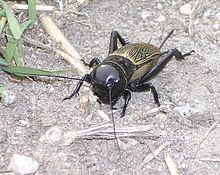Gryllus campestris
| Gryllus campestris | |
|---|---|

| |
| Scientific classification | |
| Domain: | Eukaryota |
| Kingdom: | Animalia |
| Phylum: | Arthropoda |
| Class: | Insecta |
| Order: | Orthoptera |
| Suborder: | Ensifera |
| Family: | Gryllidae |
| Genus: | Gryllus |
| Species: | G. campestris
|
| Binomial name | |
| Gryllus campestris | |


Gryllus campestris is one of many crickets known as field crickets. These flightless dark colored insects are comparatively large; the males range from 19 to 23 mm and the females from 17 to 22 mm.
Habitat
Gryllus campestris used to be common over most of Western Europe. It prefers dry, sunny locations with short vegetation, like dry grasslands. At the northern edge of its range, it is restricted to heathlands and oligotrophic grasslands. The species is flightless and unable to migrate long distances, and it therefore does not commonly recover on its own from local extinction.
Reproduction
The reproductive season of the univoltine species lasts from May to July. The males make a burrow with a platform at the entrance from which they attract females with their courtship stridulation. They chirp during daytime as well as the first part of the night, only when the temperature is well above 13 °C. Nymphs hatch in June till mid July and hibernate during their tenth or eleventh instar. The final moult takes place at the end of April or at the beginning of May. Males are territorial and defend their burrows fiercely, while females are vagrant and are attracted by singing males. They lay their eggs in bare ground either close to a burrow or inside the burrow. Populations of G. campestris are known to undergo extreme fluctuations and are strongly affected by weather conditions.
Threats
G. campestris is the most endangered cricket species in Britain. It is declining and red-listed in large parts of Central and Northern Europe, such as the United Kingdom, Germany, the Netherlands, Belgium, Luxembourg, Denmark and Lithuania. It has declined severely in part of its northern range due to the disappearance of its heathland habitat; by the early 1990s the species was reduced in the UK to a single surviving colony of just 100 individuals in Coates, West Sussex.
Conservation efforts
Fragmentation of habitats and loss of (sub-)populations have been recognized as main threats for many species, including the Field cricket. The artificial establishment of new populations is, therefore, a consistent method for enhancing the survival probability of a species. The aim of translocation projects is usually to reduce the risk of extinction for an endangered species by creating additional self-sustaining populations. Studies of translocation and natural populations of G. campestris in Germany[1] have shown that translocation does not result in a significant loss of genetic diversity. Translocation of nymphs from different subpopulations may in fact be a suitable method to decrease the loss of genetic diversity and reduce the risk of inbreeding, and large numbers of nymphs may be translocated without negative effect on the source population.[2]
References
- ^ A. Hochkirch, K. Witzenberger, A. Teerling, F. Niemeyer (2007) Translocation of an endangered insect species, the field cricket (Gryllus campestris Linnaeus, 1758) in northern Germany. Biodivers Conserv. 16:3597–3607
- ^ K. Witzenberger, A. Hochkirch, (2008) Genetic consequences of animal translocations: A case study using the field cricket, Gryllus campestris L. Biological Conservation, Volume 141, Issue 12, 3059-3068
Sources
- Pearce-Kelly P, Jones R, Clarke D, Walker C, Atkin P, Cunningham AA (1998) The captive rearing of threatened Orthoptera: a comparison of the conservation potential and practical considerations of two species’ breeding programmes at the Zoological Society of London. J Insect Conserv 2:201–210
- C. Venne, F. Ahnfeldt (2003) Neuansiedlung der Feldgrille (Gryllus campestris) in Bielefeld? Ber. Naturwiss. Verein für Bielefeld u. Umgegend, 43, 407-417
- S. Fischer (1994) Die Bedeutung der Wanderschäferei für den Artenaustausch zwischen isolierten Schaftriften. Diplomarbeit Univ. Marburg. FB Biologie, Naturschutz
- A. Hochkirch, K. Witzenberger, A. Teerling, F. Niemeyer (2007) Translocation of an endangered insect species, the field cricket (Gryllus campestris Linnaeus, 1758) in northern Germany. Biodivers Conserv. 16:3597–3607

